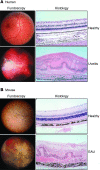A look at autoimmunity and inflammation in the eye
- PMID: 20811163
- PMCID: PMC2929721
- DOI: 10.1172/JCI42440
A look at autoimmunity and inflammation in the eye
Abstract
Autoimmune and inflammatory uveitis are a group of potentially blinding intraocular inflammatory diseases that arise without a known infectious trigger and are often associated with immunological responses to unique retinal proteins. In the United States, about 10% of the cases of severe visual handicap are attributed to this group of disorders. As I discuss here, experimental models of ocular autoimmunity targeting retinal proteins have brought about a better understanding of the basic immunological mechanisms involved in the pathogenesis of uveitis and are serving as templates for the development of novel therapies.
Figures



References
-
- Gery I, Nussenblatt RB, Chan CC, Caspi RR. Autoimmune diseases of the eye. In: Theofilopoulos AN, Bona CA, eds.The Molecular Pathology of Autoimmune Diseases . New York, New York, USA: Taylor and Francis; 2002:978–998.
-
- Nussenblatt RB, Whitcup SM.Uveitis: Fundamentals and Clinical Practice . Philadelphia, Pennsylvania, USA: Mosby Publishing; 2004.
-
- Gocho K, Kondo I, Yamaki K. Identification of autoreactive T cells in Vogt-Koyanagi-Harada disease. Invest Ophthalmol Vis Sci. 2001;42(9):2004–2009. - PubMed
-
- Gery I, Mochizuki M, Nussenblatt RB. Retinal specific antigens and immunopathogenic processes they provoke. Prog Retinal Res. 1986;5:75–109.
Publication types
MeSH terms
LinkOut - more resources
Full Text Sources
Other Literature Sources
Research Materials

